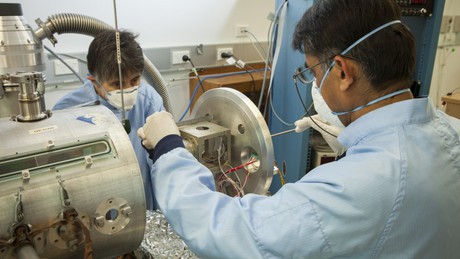Nanosatellite testing at ANU

A European satellite mission has turned to The Australian National University (ANU) to help test science units for nanosatellites ahead of a mass launch next year.
CubeSats — nanosatellites typically 10 cm3 — are emerging as a space industry standard design for low-cost space research. Originally conceived for student projects, more than 100 CubeSats have been launched around the Earth and even around Mars.
Dr Dhiren Kataria, from University College London’s Mullard Space Science Laboratory (MSSL), is currently visiting ANU to test the protoflight instrument and conduct possible further tests on instruments for CubeSats in conditions similar to the upper atmosphere. The tests will be held ahead of the launch of the QB50 space mission in 2016, which will see the mass launch of 50 CubeSats in a low orbit around Earth.
The collaboration was the result of ANU Professors Christine Charles and Rod Boswell visiting the MSSL earlier this year. According to Professor Charles, “As we explained how our unique facilities could give them the low-energy beams they need for testing, they became very excited and made plans to come to visit us immediately.
“The space simulation, plasma thruster and plasma diagnostics facilities at ANU are complementary to those at MSSL, significantly enhancing the ground calibration and testing of these instruments on Earth, which is very tricky to do.”
Facilities at ANU’s Research School of Physics and Engineering (RSPE) and Mt Stromlo Advanced Instrumentation and Technology Centre give Australia an important role in the growing CubeSat industry, Professor Boswell said. “We’re the backroom boffins in this project,” he said, “and if all goes well, more contracts will come in from other countries such as Japan, Korea or Canada.”
The QB50 program has 27 countries building satellites for the mass launch, including China, the US, Brazil and Russia. Three Australian universities are contributing CubeSats to the program: the University of Sydney, the University of Adelaide and UNSW.
Flexibly shaped mirror improves X-ray microscopes
Japanese researchers have engineered a mirror for X-rays that can be flexibly shaped, resulting...
Raman spectroscopy used to detect illegal ivory
A quick and reliable method for distinguishing between elephant and mammoth ivory has long been a...
Forensic breakthrough: drugs detected on gel-lifted fingerprints
The breakthrough could shed new light on unsolved crimes, as forensic gel lifters are used...







